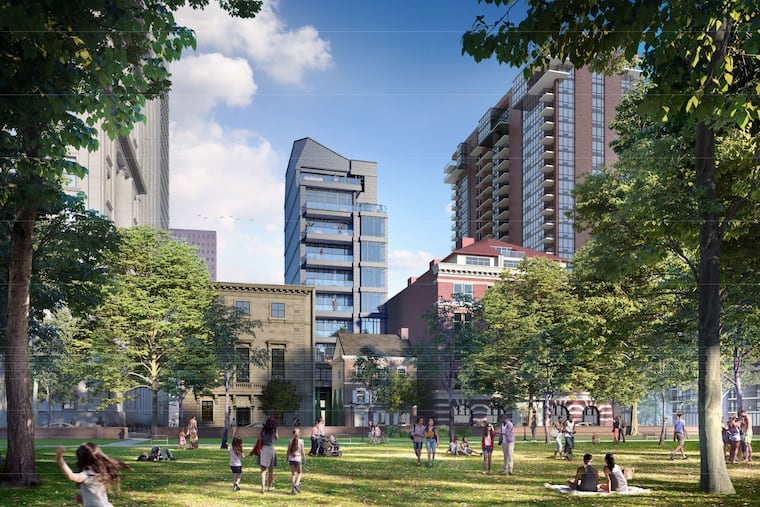Condo project at Dilworth house in Society Hill is underway after two decades of strife
A new owner has taken on the task of preserving the faux historic home and building condos around it.

More than two decades after John Turchi purchased Mayor Richardson Dilworth’s former home in Washington Square, construction is underway at 223 S. Sixth St.
After years of legal battles, Turchi won the right to build a 12-story condo building while preserving part of the older house just before the pandemic began. But the project being built today is slightly different from the version that won city approvals in 2019, having been shrunk from 10 units to nine.
And now a new owner will see it through.
“It was zoned and ready to go,” Turchi said. “But I basically retired, so it got to the point where I fell out of enthusiasm.”
City records show that he sold the parcel, which includes Dilworth’s faux-historic 1950s-era home, in January 2021 for $7.5 million. The new owner is Astoban Investments, the company behind projects at 2110 Walnut St. and the former Freeman’s auction house. Both of those efforts are new housing developments that arise behind and above historic buildings.
Astoban’s managing director, Tim Shaaban, said the company would use most of Turchi’s 2019-era design. Plans at the time showed a 12-story ultra-luxury condo building connected to Dilworth’s house by a low-slung passageway meant to be invisible from the street.
“Aesthetically, for most people, it would appear to be the same,” said Shaaban. “The differences would be really mostly how we use the space, interior-wise.”
The units will range between 2,600 and 5,000 square feet. Shaaban said that it was too soon to say exactly what the prices for individual units would be, but that they would be “in line” with the company’s other products. These range, he said, from $800 a square foot to $1,500 a square foot. That would put the largest unit between $4 million and $7.5 million, with the high end more likely.
While there has been some softening of the ultra-luxury condominium market in the city, Shaaban said that his company tends to build smaller projects and that such sales are still manageable.
“We create projects that are eight to 12 units on average, so it’s not as overwhelming as is possible for other developments” that are trying to sell many times that number of units, Shaaban said. “We’re very specific and boutique with our product … we have a list of people, many from around the square actually, as well as from other parts of the city and outside the city.”
Construction began in the fall and is expected to be completed within 24 months. The total project cost will be about $32 million.
Shaaban’s quiet completion of the condo tower marks an unexpected end to a multi-decade saga. Asked why he sold the property, Turchi replied: “It’s called make a profit and run.”
That undersells how much time and resources Turchi put into trying to develop 223 S. Sixth St., which lies in the Society Hill Historic District.
He bought the property in 2001 to serve as a single-family home, but a couple of years later unveiled a proposal for demolition of the building and construction of a 16-story condo tower by architect Robert Venturi.
That didn’t go over at all well with the Society Hill Civic Association, or local preservationists, who fought his plans all the way to Commonwealth Court. Although they were unable to wholly preserve the house, the present plan is much smaller than Turchi’s original proposal and retained the public-facing section of Dilworth’s domicile.
» READ MORE: A new Washington Square high-rise? Philly developer tries again to build condo tower over Dilworth House [from 2019]
The former mayor’s old home, which dates to the 1950s, looks more antiquated than it is. Part of a reformist Democratic Party push to take control of city government in the postwar years, Dilworth commissioned the manse as a symbol of his commitment to urban living in the white flight era.
It is of a piece with the redevelopment of Society Hill, which around the same time was transformed from one of Philadelphia’s poorest neighborhoods into one of its poshest sections. Many low-income residents were displaced for the urban renewal project, which combined historic homes with modern architecture.
The new version of the neighborhood was meant to serve as proof that urban neighborhoods could retain middle- and upper-class households (and their tax dollars) even as the suburbs boomed and drained resources from cities.
Shaaban said that his company is working on material and color details with the Philadelphia Historical Commission and that his company is taking care of the contents of the Dilworth house.
“Anything removed is being cataloged and placed in storage,” he said. “A lot of it will be returned. Anything historic or representative of Dilworth or the mayor or any representation of the original house will be placed back and represented in our project.”